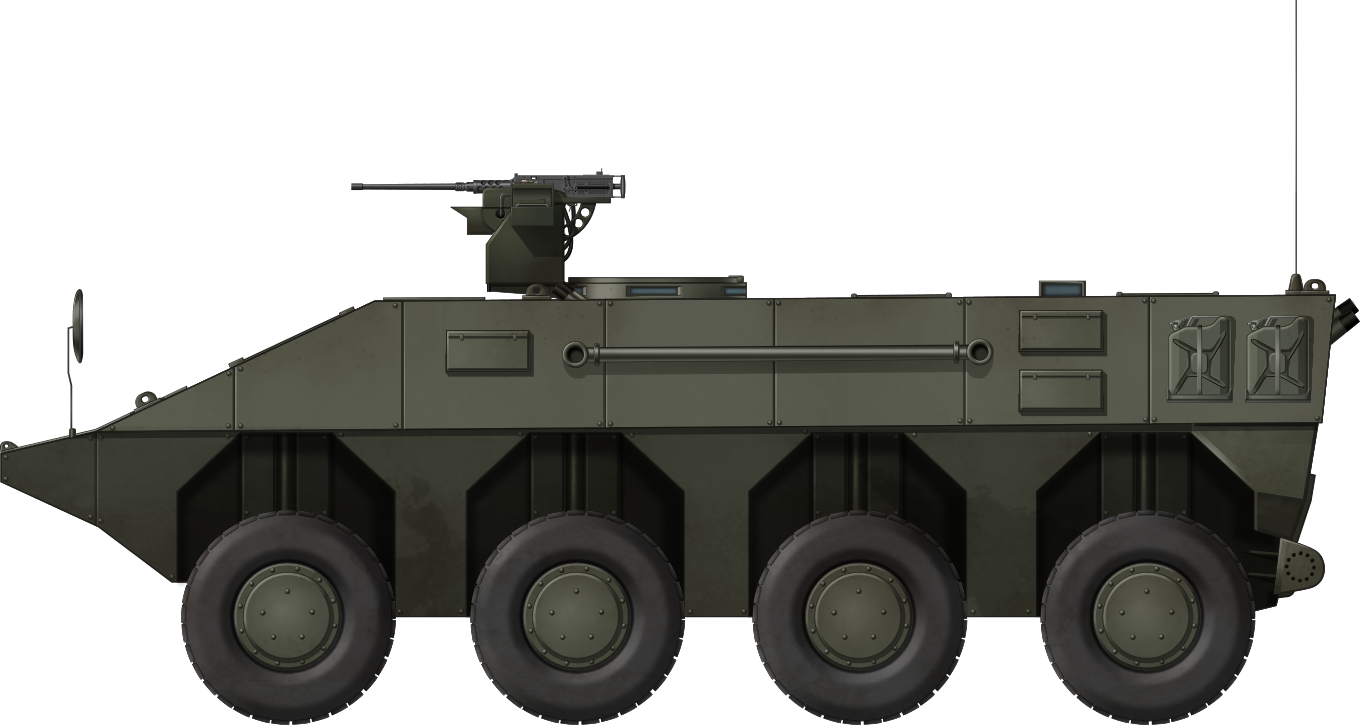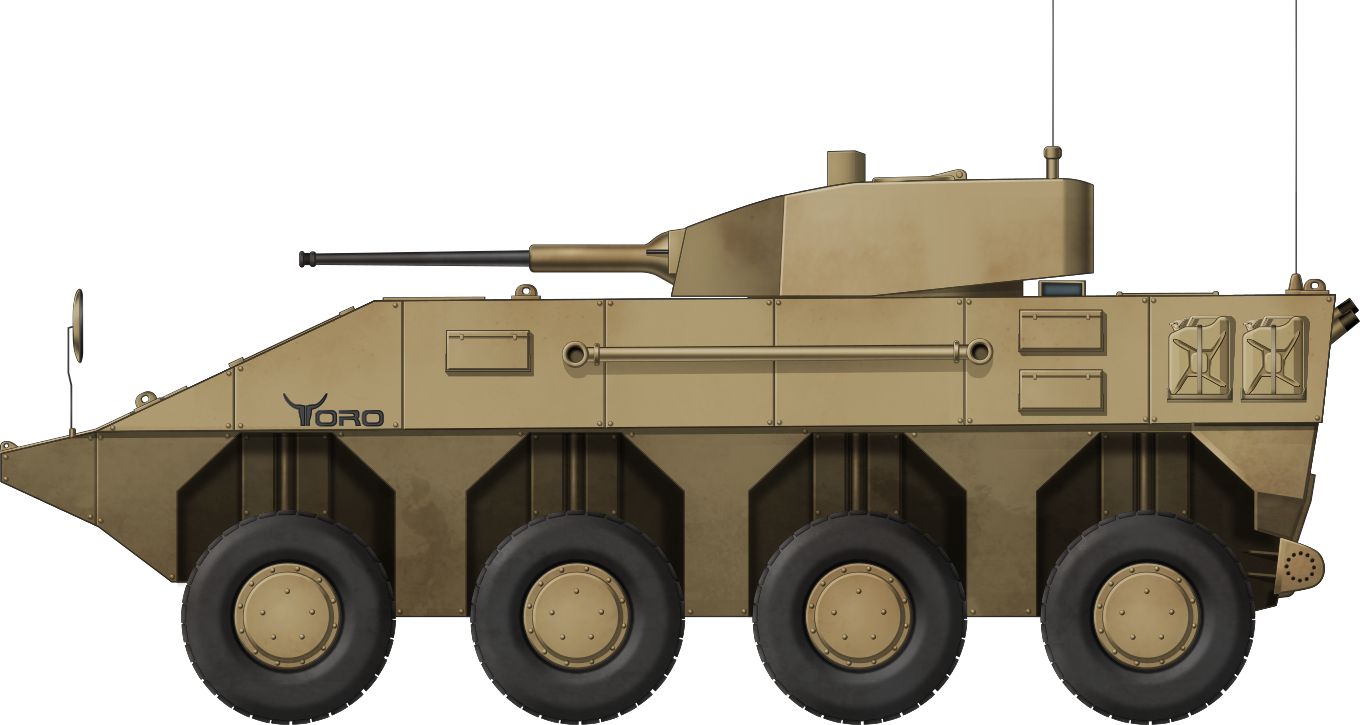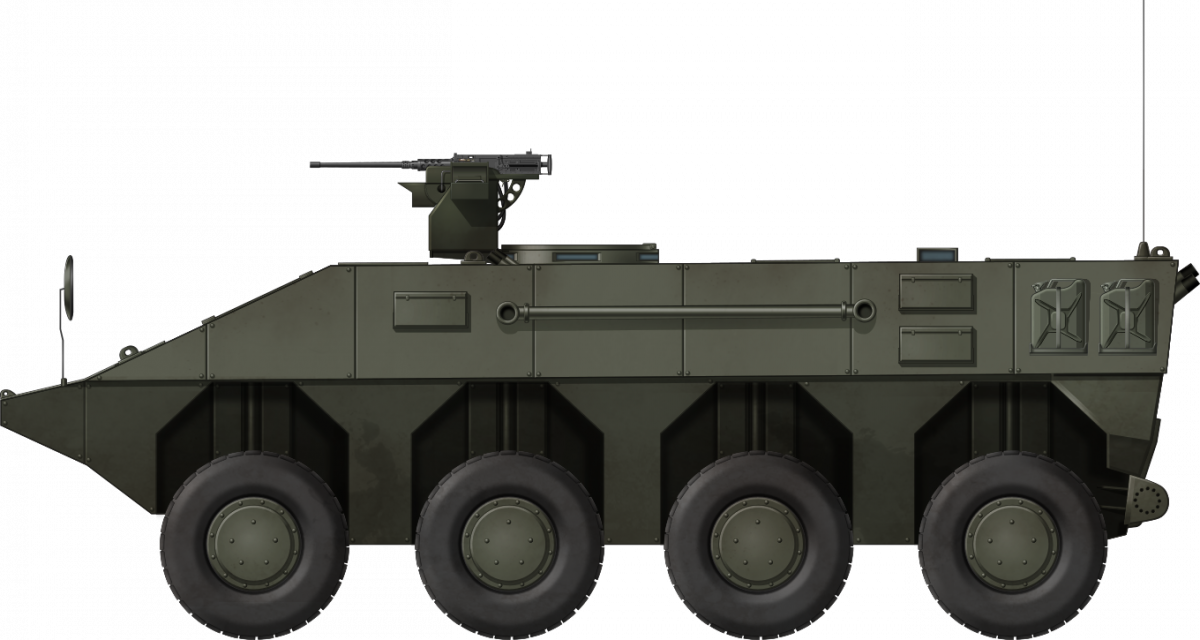 Kingdom of Spain (2010)
Kingdom of Spain (2010)
8×8 Infantry Fighting Vehicle – 1 Partially Constructed Prototype

In 2007, the Spanish Army underwent a substantial transformation due to the noticeable obsolescence of much of its equipment. This prompted the launch of new projects, including the VBR (Vehículo Blindado sobre Ruedas – Armored Wheeled Vehicle) program. This initiative aimed to create an advanced 8×8 vehicle to replace the BMR (Blindado Medio sobre Ruedas – Medium Wheeled Armored Vehicle) and VEC (Vehículo de Exploración de Caballería – Cavalry Exploration Vehicle), both in widespread use in the Spanish Army. While the Swiss Piranha V served as the primary basis for this development programme, Spain also worked on an exclusively indigenous 8×8 vehicle family, the TORO.

Historical Context
The BMR, initially introduced in Spain in 1980 and developed by the Spanish company ENASA (Empresa Nacional de Autocamiones S.A. – Truck National Limited Company, later absorbed by Iveco), has been a stalwart in the country’s military operations. However, the passage of time, and notably its thinly armored aluminum structure, have rendered it obsolete in the face of advancing technologies.
Spanish forces have used the BMR in peacekeeping missions in Afghanistan, Iraq, and the former Yugoslavia. In addition to Spain, the BMR has been exported to Egypt, Peru, and Saudi Arabia, where it has been fighting in the war in Yemen since 2015.

In contrast, the VEC, a 6×6 reconnaissance vehicle directly derived from the BMR chassis, equipped with a 25 mm gun, has served exclusively within the Spanish Army. It has played roles in KFOR (Kosovo Force), Lebanon, and Iraq, providing support to infantry squads.

Despite their overall great service, both the VEC and particularly the BMR faced criticisms regarding their effectiveness. In Afghanistan, their aluminum armor proved insufficient against the improvized explosive devices used by the Taliban in attacks on Spanish forces during patrols. This vulnerability significantly increased the risk of crew casualties. To counter this threat, the Spanish Army began acquiring RG-31 Nyala mine-resistant vehicles to replace the BMR, indicating the need for a newer, more robust vehicle to replace these aging models.

In Search of a Replacement
In 2004, the VBMR (Vehículo Blindado Modular sobre Ruedas – Armored Modular Wheeled Vehicle) program was initiated, but it was not until four mine attacks resulted in eleven casualties among Spanish troops in Lebanon and Afghanistan that the Ministry of Defense launched the VBR (Vehículo Blindado sobre Ruedas – Armored Wheeled Vehicle) program in 2009. The goal was to develop an 8×8 vehicle to replace the Spanish BMR and VEC vehicles.
The initial procurement plan outlined the acquisition of 300 vehicles in the first phase after selecting the 8×8 model, with an additional purchase of 1,200 vehicles in subsequent phases. Future considerations included developing specialized variants such as recovery, ambulance, combat engineer, training, mortar carrier, Explosive Ordnance Disposal, and advanced observation vehicles.
The procurement aimed at two primary configurations:
- a basic troop transport version to replace the BMR
- a cavalry reconnaissance model intended to replace all VEC M1 vehicles. This latter variant was to be equipped with a turret housing a 30 mm gun or a more potent armament, along with anti-tank missiles
To ensure flexibility and the opportunity for companies to propose the most suitable vehicle or even present multiple models, the requested characteristics and capabilities were intentionally kept broad and general. This approach aimed to encourage a diverse range of proposals and innovative solutions that could meet the Army’s requirements without overly restrictive specifications.
- High protection for the crew
- High load capacity and enough internal volume
- High mobility to allow fast deployment, in the strategic, operational, and tactical field
- Low service cost
- The vehicles should be modular
- The proposal should at least be in service in one country, documenting the variants it uses. This requirement was not fulfilled by certain proposals
In may 2009, the DGAM (Dirección General de Armamento y Material – General Directorate of Armament and Material) contacted eight companies regarding their 8×8 vehicles that could meet the Army’s requirements. These companies were:
- BAE Systems-Hägglunds, which presented the SEP
- Consorcio Iveco-Oto Melara, presented the VBM Freccia
- General Dynamics Santa Bárbara Sistemas, presented two vehicles, the Piranha III, which did not meet the requirements but was already in service in the spanish marines, and the Piranha V, which was not still in service in any country
- General Purpose vehicles, which presented the GPV Colonel
- Krauss-Maffei Wegmann, presented the GTK Boxer
- Nexter, presented the VBCI
- Patria, presented the AMV
- Thales Australia, which is an interesting candidate, as the company did not build any 8×8 and as such did not offer any 8×8 to the request.
The initial calendar for the VBR program was:
| 15 August 2009 | Deadline to send proposals to the Spanish Ministry of Defense |
| December 2009 | Evaluation and selection of the vehicles |
| January 2010 | Request of the offers |
| June 2010 | Signing off contracts |
| 2012-2016 | The first 300 vehicles of the first phase to be sent, with a minimum of 40 vehicles in 2014 |
The initial plan suffered many delays caused by the severe financial crisis that hit Spain in 2007 and 2008, which caused cuts in many areas, including military projects.

The program extended beyond direct invitations to companies, opening the opportunity for broader participation. By including the program in the Ministry of Defense’s portal, it enabled any company to submit their 8×8 proposals, even if they were not initially invited to participate. This inclusive approach led to the submission of additional proposals, such as the Ukrainian BTR-4 by Kharkiv Morozov and the TORO by NTGS.

The TORO – NTGS’ Proposal
New Technologies Global Systems (NTGS), a Spanish private company founded in 2002 and headquartered in Madrid, specializes in designing armament systems and developing specialized vehicles. Their portfolio includes weapons that are currently in service in other nations. Notably, one of their creations is the Alakran mortar system, which could be mounted in a variety of vehicles. Interestingly, this system has been observed in use by the Ukrainian Army, mounted on the BARS-8 armored wheeled vehicle, amidst the ongoing conflict in Ukraine.
NTGS has also been actively involved in various Spanish projects. Recently, they proposed a joint development with the Brazilian company Avibras for a Multiple Rocket Launch System (MRLS).


NTGS recognized the opportunity that appeared with the announcement of the VBR program and embarked on designing a wholly indigenous 8×8 vehicle. As the deadline approached, the company managed to present a first 8×8 design, initially unnamed. This design, later refined and further developed, eventually became known as the ‘TORO’.


In 2010, NTGS unveiled their TORO design as an 8×8 vehicle specifically intended for the VBR program. Notably, their proposal stood as the only submission within the program that had not yet reached completion.

The TORO vehicle quickly garnered attention due to its features. One standout aspect was its price per unit, set at a significantly lower €1.5 million, compared to the average proposal cost of €3.6 million from the other contenders.
Additionally, the vehicle had a remarkably reduced weight, tipping the scales at just 19 tonnes. This was achieved through an innovative hybrid diesel-electric setup propulsion system. This unique system allowed for the utilization of thermal engines with lower power requirements while eliminating the need for a gearbox and traditional mechanical transmissions to the wheels.

Name
Unlike other Spanish projects, where the names are acronyms representing the intended vehicle role, as with the BMR and VEC, the name TORO directly translates to ‘bull’ in Spanish. It specifically references the Toro de Lidia, also known as Toro Bravo, a breed of bovine found in Spain and Portugal deeply linked to Spanish culture, notably associated with bullfighting.

Design
The TORO’s design specifics remained under wraps due to confidentiality agreements. Nevertheless, key aspects were highlighted, especially the emphasis on crew protection from mines and truck bombs, which was a crucial improvement over the vulnerability seen in the BMR during operations abroad.
The TORO was designed to be 7.42 m long, 2.5 m wide, and 2.31 m tall, making it quite a compact vehicle. Weighing just 19 tonnes, its lightweight construction was facilitated by the use of a hybrid electric-diesel propulsion system, distinguishing it from other vehicles in its class. The vehicle boasted a ground clearance of 0.5 m.
Moreover, the TORO’s notable features included high modularity and cost-effectiveness. Its ability to maintain a lower unit price was largely due to the incorporation of commercial components.
Another notable feature of the TORO was its complete amphibious capability, a feature the BMR did not possess.

Armor and Protection
While specific details about the materials used in the construction of the TORO vehicle were not explicitly disclosed, observations from available images suggest that it might have been intended to be constructed primarily from steel, potentially incorporating ceramic armor elements.

NTGS claimed that the TORO had mine protection rated at 4A (withstanding 10 kg of TNT impacting any wheel) and 4B (withstanding 10 kg of TNT at the center of the vehicle). According to NTGS, the vehicles with similar mine protection levels among the VBR proposals were the AMV, Boxer, Piranha V, and VBCI.
The TORO’s belly protection was designed to withstand the impact of an improvised explosive device (IED) equivalent to 150 kg of TNT detonated at a distance of 5 m. According to NTGS, this level of belly protection was matched only by the Boxer and Piranha V among the vehicles evaluated. They attributed this level of protection at such a low weight to the innovative lightweight propulsion system utilized in the TORO.
Additionally, if deemed necessary, the TORO could have been outfitted with extra armor, such as slat armor.

Propulsion
The propulsion system was one of the most curious aspects of the design. It featured two 105 hp diesel engines of unknown origin positioned at the front of the vehicle, accompanied by eight 67 hp electric engines located within each wheel hub. This setup enabled the TORO to move up to an additional 20 km solely on battery power with the main engines off. Additionally, in case of a malfunction in one of the diesel engines, the vehicle retained reduced mobility.

Crew, Hull, and Internal Layout
The TORO’s hull design followed a conventional approach, bearing similarities to other NATO vehicles, such as the Piranha V or the GTX Boxer. It featured sloped front armor and flat sides, with the two diesel engines positioned at the vehicle’s front.
Accessibility for the crew was facilitated through a hatch located on the top of the vehicle. Operating the TORO required just two personnel: a driver and a commander. The driver occupied the front center position of the vehicle, while the commander was situated just below the vehicle’s hatch top.
In its APC (Armored Personnel Carrier) configuration, the vehicle has the capacity to accommodate nine individuals at the rear, accessible through a large door situated at the back of the vehicle. The seating arrangement consisted of two rows of seats running parallel to the vehicle’s sides. The right side held five seats, while the left side accommodated four seats.


Turret and Armament
The standard configuration of the TORO includes the CAZADORA (Hunter) turret, a two-axis stabilized Remote Controlled Weapon Station (RCWS) developed by NTGS. This turret enables observation, target acquisition, and firing capabilities while the operator remains safely inside the vehicle. One of its features is its versatility, as it can be mounted on various light vehicles, such as the BMR, HUMVEE, or VAMTAC without requiring alterations to the original vehicle’s design.

The CAZADORA turret can be remotely controlled. It includes a rangefinder, stabilized shooting mechanisms, optical tracking systems, and the optional integration of thermal imaging technology.
Regarding armament options, the CAZADORA turret can be fitted with either a Browning machine gun or a 40 mm automatic grenade launcher. In the context of a hypothetical service within the Spanish Army, the LAG-40 automatic grenade launcher, already in use within certain vehicles, including the BMR, could be a likely choice for armament if the TORO had entered service.
The fire-control system would have been housed within the vehicle, featuring an operator’s display and a manual control joystick. Integrated sensors included a high-resolution day video camera, an electronic panoramic vision system providing a 360º view, and a shooting control system facilitating ballistic corrections.
Technical Details of the CAZADORA remote controlled weapon station (taken from the manufacturer):
| Direction range | 3×360º |
| Elevation range | 80º to -20º |
| Max. Direc/Elevation speed | 90 º/s |
| Min. Direc/Elevation speed | 0,1 º/s |
| Accuracy | 0.1 mil |
| Stability under fire | 2 mil |
| Weight | < 60 kg |
| Height | < 600 mm |
Suspension
The TORO featured a hydropneumatic adjustable suspension system, independent for each wheel. This suspension setup provided the vehicle with the ability to maintain comfort and stability while traversing varied terrain, including inclined areas.

Variants
TORO ‘Vehículo Exploración de Caballería’
The TORO ‘Vehículo Exploración de Caballería’ (Cavalry Exploration Vehicle) would have served as a reconnaissance variant of the 8×8 designed to replace the existing VEC in the Spanish Army. Notably, it would have been equipped with a 30 mm gun encased within a closed manned turret. While the exact gun model was not specified, it could potentially have been the Mk44 Bushmaster II. This supposition arises from the fact that the future 8×8 vehicles in service are slated to utilize this cannon. Moreover, the other 30 mm cannon utilized by the Spanish Army, the Mauser MK 30 in service with the Pizarro infantry fighting vehicles, has reportedly faced recurring issues related to gas evacuation. Although it was never confirmed, considering the specifications of the reconnaissance variant of the VBR, probably the turret was also equipped with a coaxial machine gun, as well some sort of anti-tank missile launcher.


Mortar-Carrier
NTGS also designed a variant designed to carry a mortar. While the exact caliber was not specified, judging by the dimensions, it possibly accommodated a 120 mm mortar.
Taking into account the mortars presently employed by the Spanish Army, the chosen model for hypothetical service might have been the ECIA L-65/120. This 120 mm mortar, of Spanish origin, is currently mounted on vehicles like the BMR and even the M113.

Rejection
Based on the available information up until the end of the official updates on the TORO, it seems that by February 2010, according to the company, NTGS had completed approximately 80% of the prototype, focusing on the chassis and collaborating with other companies to integrate various systems. DGAM planned to visit NTGS’ installations to assess the TORO’s progress before the end of that month and discuss the offers. Additionally, NTGS aimed to have the prototype ready for presentation by the end of summer for the VBR program.
However, as there is no further official information beyond this point, and assuming the timeline and operational readiness based on the available data, it is plausible to infer that by the end of that summer, the TORO prototype might not have been fully operational. It is feasible that, due to its incomplete status or other operational reasons, the TORO might not have met the necessary criteria or standards set by the DGAM, potentially leading to its rejection in favor of other proposals that were more advanced or operational at that time.
In the end, the vehicles chosen for the VBR competition in April 2011 were:
- the German Boxer
- the French VBCI
- the Italian Freccia
Despite this, the VBR program faced cancellation due to military budget cuts amid Spain’s economic crisis. However, in 2013, there was a revival of the program under the new name VCR (Vehículo de Combate sobre Ruedas – Combat Wheeled Vehicle). Instead of continuing the progress initiated by VBR, the program was restructured, and the whole project was adjudicated to a collaboration between the Spanish companies General Dynamics Santa Bárbara Sistemas, Indra, and Sapa. The objective was to develop the future 8×8 vehicle for the Spanish Army, utilizing the Piranha V as a base, potentially manufactured under license by Santa Bárbara Sistemas. This collaborative effort eventually led to the creation of the current VCR Dragón.

A New TORO?
Established in February 2012, TORO VES (TORO Vehículos Especiales y Sistemas – TORO Special Vehicles and systems) was a collaboration between the company NTGS and Everis Group. The Everis Group is a multinational specializing in advanced technological systems for the civilian and military market. Initially focused on unmanned aerial vehicles, they have recently expanded their operations into the ground vehicles market. Within this group are companies such as Quatripole, known for developing the Q-150D aero-transportable vehicle used by the Spanish paratrooper brigade, and more recently, NTGS.
During TORO VES’ inaugural year, the company unveiled two new TORO variants, one tailored for firefighting and another as a command version. Notably, this introduction came a year after the announcement of the VBR program finalists. This timing suggests that NTGS might have sought to reinvigorate the TORO design, possibly redirecting its focus away from the Spanish military. However, the absence of photographic evidence or official announcements regarding acquisitions by firefighting brigades or police forces suggests that the vehicle might not have gained traction in the market. It is essential to highlight that the TORO VES is currently inactive.

Conclusion
The TORO’s involvement in the VBR program represents an attempt to develop an advanced military vehicle that aimed to offer protection, performance, and cost-effectiveness. However, its journey reveals several considerations.
Initially promising in innovation, the TORO faced challenges during its development. The pressure to meet program deadlines and expectations might have compromised the effective execution of the project. Technical complexity and the need for sufficient funding could have been significant obstacles for NTGS, which had little experience building full AFVs from the ground up.
Additionally, collaboration and competition among different companies in the military sphere were evident in the program’s revival through a partnership among Spanish firms. Competing with more established proposals might have posed an added challenge.
Additional Photos





| TORO | Piranha VE | Piranha IIIE | Freccia VBM | GTK Boxer | AMV | VBCI | SEP | |
|---|---|---|---|---|---|---|---|---|
| Country origin | Spain | Switzerland | Switzerland | Italy | Germany | Finland | France | Sweden |
| Crew | 2+9 | 3+8 | 3+8 | 3+8 | 3+7 | 3+10 | 3+8 | 3+10 |
| Weight in combat (Tonnes) | 19 | 30 | 25 | 26,2-30 | 33 | 26 | 28 | 24-27 |
| Maximum load (Tonnes) | 8 | 15,5 | 11,8 | 10 | 8 | 10 | 10 | 12,5 |
| Length (m) | 7,42 | 7,54 | 7,3 | 7,93 | 7,93 | 7,7 | 7,8 | 6 |
| Width (m) | 2,5 | 2,98 | 2,66 | 2,99 | 2,99 | 2,8 | 2,98 | 2,8 |
| Height (m) | 2,31 | 2,34 | 2,22 | 2,01 | 2,37 | 2,3 | 2,26 | 2,2 |
| Engine (hp) | -2 diesel engines with 105 HP each | 584 | 457 | 550 | 720 | 540 | 550 | -2 diesel engine 270 HP each one |
| -8 electric engine of 67 HP in the hub of each wheel | ||||||||
| Max velocity (km/h) | 110 | 100 | 105 | 108 | 103 | 100 | 100 | <110 |
| Specific power (HP/tonne) | 28,2 | 19,4 | 18,2 | – | 21,8 | 20,76 | 19,64 | 20 |
| Autonomy (km) | 1000 | 700 | 650 | 800 | 1050 | 600-800 | 750 | 600 |
Comparison of the TORO with others 8×8 presented in the VBR program. Source: PRESENTE Y FUTURO DE LOS MEDIOS ACORAZADOS ESPAÑOLES – EXPAL EN EL MANTENIMIENTO Y MODERNIZACIÓN DE VEHÍCULOS BLINDADOS – INFODEFENSA (readkong.com)
Sources:
NTGS y Avibras presentan el consorcio Ibermisil como candidato al SILAM – Noticias Defensa España
Programa VCR 8×8: entre la necesidad y la incertidumbre – Ejércitos (revistaejercitos.com)
(37) TORO 8×8 Nuevo vehículo de combate híbrido español – YouTube
NTGS — Seguridad y Defensa (archive.org)
Defensa prevé firmar el contrato del vehículo 8×8 Dragón en agosto (abc.es)
Se calienta la competición por el VBR 8×8 (archive.org)
TORO VEHICULOS ESPECIALES Y SISTEMAS: SARFIREX (youtube.com)
El VCR 8×8 “Dragón” para el Ejército de Tierra – Noticias Defensa España
IDS. (2014, january). SPAIN Defence & Security 2014., 62-65.


